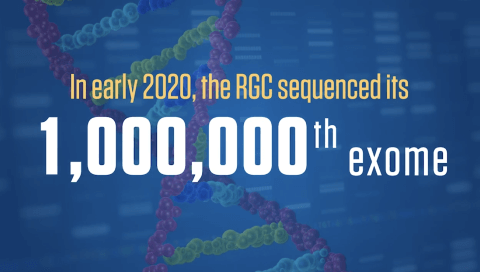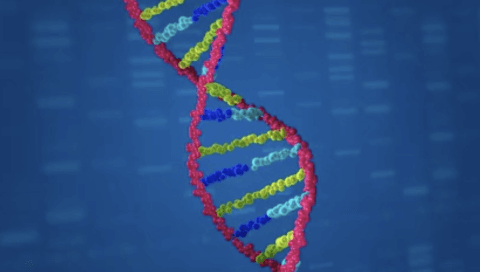Genetics
A Million Is Just The Beginning
February 28, 2020
The Regeneron Genetics Center® (RGC™) just celebrated sequencing its one millionith exome. Learn how we got here and what we're aiming for next.
By: John Overton, PhD, Vice President and Chief Sequencing Officer

The Regeneron Genetics Center® (RGC™) just celebrated the sequencing of its 1,000,000th exome. That’s an astonishing amount of data and a testament to the strength of our technology and collaborations. As we reflect on the signficance of the big 1 MILLION and what we are aiming for next, I’m going to share with you how we got here.

Genesis of the idea
When I arrived at Regeneron in 2013, RGC didn’t exist yet. Instead, there was a top-secret program called the Human Genetics Initiative, with only Senior Management and a few select colleagues involved. There were no other employees, no samples, and no equipment, and our space was in a remote area on the far side of the campus, away from the rest of the company. However, we had plenty of ambition and a big idea: to build a technologically advanced genetics center that could uncover insights to transform our understanding of human health and biology.
I had just come from academia along with a few members of my team. We had deep expertise in biology, genetics, and next-generation sequencing, but we were venturing into uncharted territory. It was like we were working at a tiny startup, not a rapidly growing biotech coming off one of the most successful drug launches ever. At the same time, we had the full support and might of Regeneron with the long-game in mind, a deep scientific rigor and innovation, and resources that no tiny startup gets to have. We had the best of both worlds. We got to build something special on the same foundation and with the same people that built Regeneron.
Although I had deep faith in my team and we had all these Regeneron advantages, I never imagined we would build something as powerful and advanced as what RGC is today.
My task was to create a sequencing lab capable of collecting large amounts of genetic information that, when paired with medical records, would serve as a valuable research tool about health and disease. We agreed that automation would be the key to our success. But there was one big problem: such automation didn’t exist. So we worked with Regeneron’s Automation team to design novel automated systems for DNA sample preparation and exome capture – tedious processes that, until then, were done almost entirely by hand. These “first-generation” robots made me finally feel confident in our ability to create technology that could keep up with the rapidly-increasing speed of sequencing machines. (Our fourth-generation, most sophisticated and advanced robots just got installed.)
Bumps along the way
We encountered some hiccups in those early days. For example, the equipment necessary to automate PCR (a common method for copying DNA sequences) wasn’t available from any of the standard equipment providers in the United States. We instead ordered it from Germany, and of course the instructions were all in German. We stubbornly tried to make the equipment work without being able to read the directions but eventually had to scramble to find someone to translate for us. I also remember an unfortunate leak in a ceiling, and a summer when the HVAC fought a valiant battle against the sun and often lost. But for each obstacle, the team came up with creative solutions to keep us moving forward to bring the lab online.
Bringing on collaborators
Still, one crucial component was missing: we needed DNA from consenting patient volunteers to fill the sequencing machines that we were building. That required external partners who were willing to share samples. It wasn’t easy in the early days to bring on collaborators, but we finally established our first big partnership with Geisinger Health System in January 2014. With this, it was time for us to make our big debut. In a New York Times article, the Human Genetics Initiative was officially announced as the Regeneron Genetics Center (RGC), and everyone was buzzing about it. There are some great stories behind the name and that article, but we’ll save those for another day.
The shiny new name notwithstanding, RGC was still just a modest operation. We started out with eight sequencing machines, which was respectable but nowhere near the size of the biggest facilities at the time. Our machines sat dormant for months while we continued to prepare the lab and wait for samples.
Streamlining the process
Our first sample was sequenced in July 2014, just about a year after I joined the company, and we processed 20,000 exomes in the second half of 2014. That number was a big turning point – we had just completed our annual goal in less than half the time expected. Our team was relatively small compared to the amount of data we produced.
Since then, we’ve continuously improved our approach. We’ve built faster, more efficient automation, which together with more powerful sequencing machines from Illumina, has doubled our sequencing output every year. As our technology has advanced, our supply of DNA samples has also grown tremendously. We have important collaborators all over the world, including the UK Biobank, University of Pennsylvania, Clinic for Special Children, Columbia University, and many, many other leading institutions. In return, those partners get valuable new information that can improve their research efforts, patient care, and, hopefully, health outcomes.
Reaching 20,000 exomes so quickly was a critical demonstration that our approach was going to work, and the remarkable speed and efficiency made us realize how big an impact automation could have on this process.
Today, the RGC has advanced high-throughput sequencing machines and autonomous robots handling samples around the clock. Our original annual target of 20,000 exomes can now be sequenced in just one week. And rather than operating in quiet seclusion, we work in a bright, glass-walled lab that’s deeply integrated with other teams at Regeneron.
Transforming medicine
Ultimately, though, our mission is not about technology or automation or efficiency – it’s about improving human health through a massive collective effort. A million sequenced patient volunteers have helped us make important progress and learn fascinating new things about the human body, but there’s still much to be uncovered. I’m grateful to our collaborators for their partnership, to the patient volunteers who have trusted us with their genetic data, and to Regeneron for taking a chance on a group of young scientists who wanted to build a new way of doing genetic research. This milestone is a true testament to the power of collaboration, and as we continue on to the next million exomes, I’m excited to see how working together can continue to transform medicine and make a real difference in people’s lives.